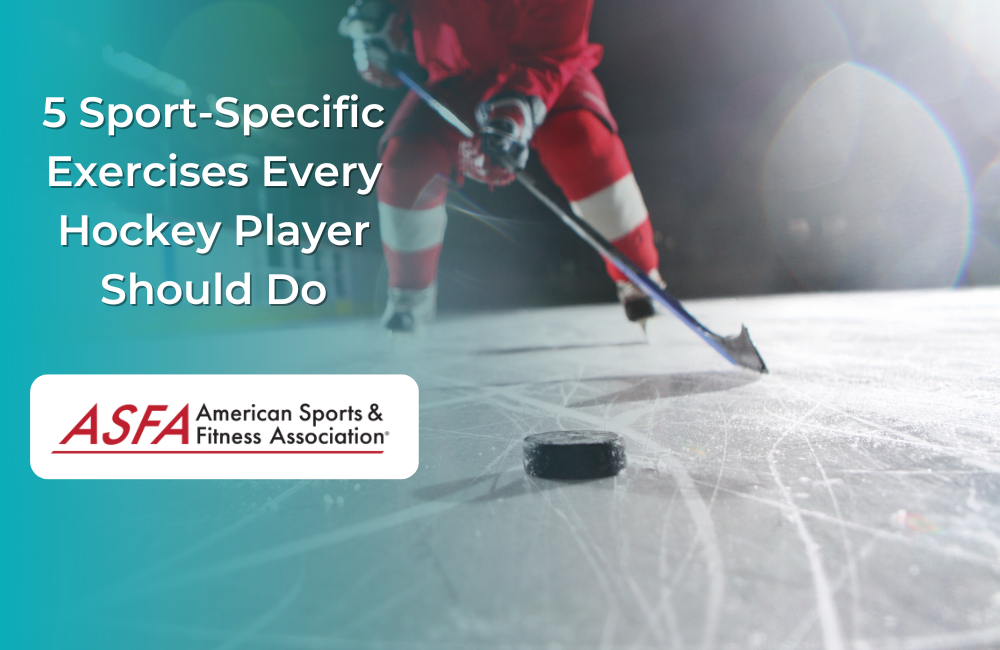Hockey is a fast-paced sport that requires power, strength, and endurance. If you want to improve your game, adding these five exercises to your routine can help increase your overall power output while improving balance, agility, and flexibility.
Squats
Squats are a basic exercise that works your hamstrings, quadriceps, and glutes.
To perform squats:
- Place a chair in front of you with your feet shoulder-width apart. You can also use a wall for support if no chairs are available.
- Bend at the knees and hips until your thighs parallel the floor (or as low as they can go). Hold this position for 2 seconds before returning to standing; repeat ten times for 1 set or 15 times for two sets per day.
. You can also perform squats while holding a dumbbell or weight plate in each hand.
Lunges
This exercise is great for strengthening your legs. As a hockey player, you're on your feet for long periods during games and practice sessions. Lunges help build strength in the muscles that support your knees and lower back so that you can stay upright without getting tired as quickly.
Lunges are also good for building endurance in the quadriceps muscle group- the large muscle group on the front of each thigh- and working out the glutes (buttocks) and hamstrings (back of thigh).
Here's how to do them:
- Stand with feet shoulder-width apart; hold dumbbells at sides or place hands on hips if no equipment is available.* Step forward with the left foot while keeping toes pointing forward; bend both knees until thighs parallel the floor.* Return to the start position by pushing off the right foot as soon as possible after completing the rep.* Repeat ten times before switching sides.* Aim for three sets total per leg
Step Ups
Step-ups are a great way to build strength in your legs and core. Start with one foot on a bench or box, then step up onto it with the other foot. Once you're on top of the bench, slowly lower yourself until both feet are flat on the floor again. Repeat 10-12 repetitions per leg before taking a small break and switching sides.
- Make sure you keep your weight on your heels rather than allowing it to shift forward onto the balls of your feet as you lift each time; this will help engage more muscles and keep tension throughout each rep.*
- It's important for hockey players and anyone who wants toned legs!
Deadlifts
Deadlifts are a compound exercise that works your back muscles, glutes, hamstrings, and quads. They're an effective way to build strength and help prevent injury properly.
- Place a barbell on the floor with weights on each side (the weight should be about 50 percent of what you can lift). Stand tall with feet hip-width apart and toes pointed forward or slightly outwards (depending on how you feel most comfortable).
- Grab hold of the barbell with an overhand grip--your hands should be just outside shoulder width apart; if there's not enough room for this position, try using straps instead of gripping directly onto the bar. Pull up so that it touches your chest while keeping your arms straight; then lower back down slowly until your legs are bent at 90 degrees.*
Reverse hyperextensions
Reverse hyperextensions are a fantastic exercise that can help you improve your lower back strength and stability. This is important because hockey players are prone to lower back injuries, which can sideline them for weeks or months.
The reverse hyperextension machine is one of the most common pieces of equipment in any gym. The way it works is simple: you lie down on your stomach with your feet on footrests, then use your glutes (butt muscles) to raise yourself until only your shoulders, neck, and head remain in contact with the bench surface below you.
Once you've mastered this basic movement pattern, there are several ways that you can progress over time:
- Increase resistance by adding more weight plates onto each side of the barbells attached to each leg rest pad;
- Perform multiple sets with fewer repetitions per set; or
- Perform single-leg versions where each leg lifts independently instead of together as normal squats do--this allows a greater range of motion than regular squats would allow because there isn't any interference between limbs during movement patterns like these!
Conclusion
These five sport-specific exercises will help you excel on the ice. The squat is a fundamental movement pattern that can improve your skating ability by strengthening your glutes, quadriceps, and hamstrings. Lunges are great for building hip and knee stability while improving balance during skating drills. Step-ups are another exercise that targets the glutes while improving strength in the lower body muscles needed during hockey games when players must jump off one leg while carrying heavy equipment like pads or pucks. Deadlifting will strengthen your core muscles like abs and lower back, which will help keep you upright when doing squats or lunges and resist falls when getting hit by other players trying to knock them down! Finally, reverse hyperextensions target those hamstring muscles responsible for pushing off when skating forward quickly; this exercise also builds explosiveness from slow movements at first before adding speed over time.





